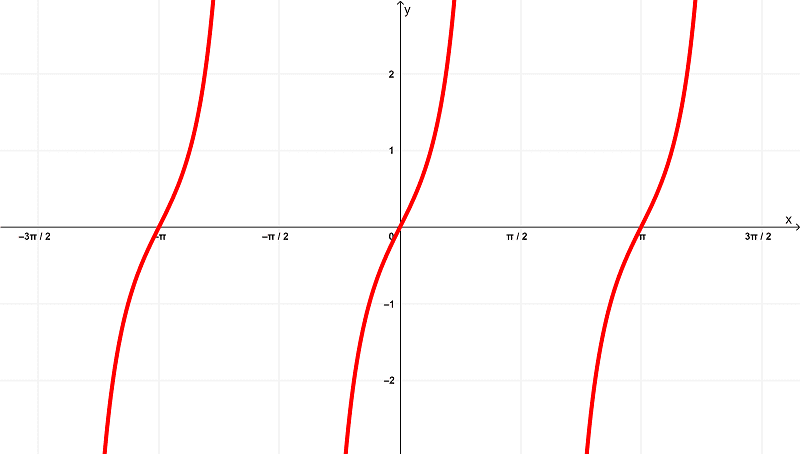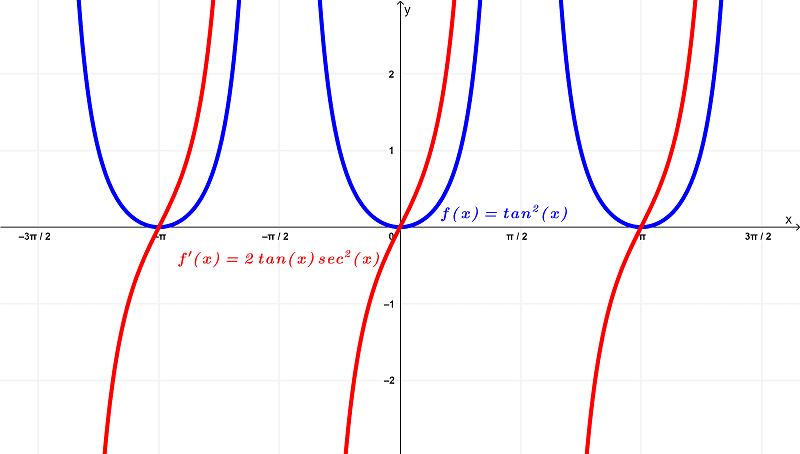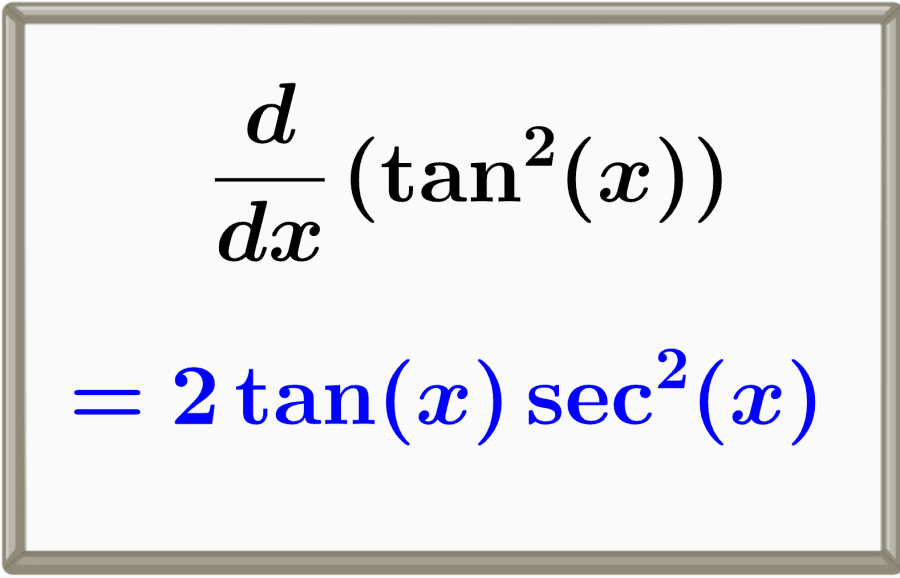The derivative of tangent squared is equal to two times tangent times secant squared, 2tan(x)sec2(x). This derivative can be calculated using the chain rule and the derivatives of the fundamental trigonometric functions.
In this article, we will learn how to calculate the derivative of the tangent squared function. We will learn about its proof, the graphical comparison of tangent x squared and its derivative, and some examples.
Proof of The Derivative of Tangent Squared Function Using Chain Rule
You are encouraged to review the chain rule formula, as a prerequisite of this topic, by visiting this link: Chain Rule of derivatives. Likewise, you may visit this another link for the proof of the derivative of tangent function: Derivative of Tangent, tan(x).
Please take note that
$latex \tan^{2}{(x)} \neq \tan{(x^2)}$
We can use the chain rule to derive this function since it is a composite function. Therefore, we start with
$latex F(x) = \tan^{2}{(x)}$
We note that there are two functions that make up F(x), a power function and a trigonometric function. Specifically, they are a function raised to a power of two and a tangent function.
If we rewrite the function in the following way, we can visualize this in a better way:
$latex F(x) = \tan^{2}{(x)}$
$latex F(x)= (\tan{(x)})^2$
Now, we can clearly see that the tangent function is the inner function and the power function is the outer function. Then, we can write:
$latex f(u) = u^2$
where
$latex u = \tan{(x)}$
If we denote the tangent function as g(x), we have
$latex f(u) = f(g(x))$
$latex u = g(x)$
$latex g(x) = \tan{(x)}$
Deriving the outer function f(u) using the power rule in terms of u, we have
$latex f(u) = u^2$
$latex f'(u) = 2u$
Deriving the inner function g(x) using the derivative formula of trigonometric function tangent in terms of x, we have
$latex g(x) = \tan{(x)}$
$latex g'(x) = \sec^{2}{(x)}$
Algebraically multiplying the derivative of outer function $latex f'(u)$ by the derivative of inner function $latex g'(x)$, we have
$latex \frac{dy}{dx} = f'(u) \cdot g'(x)$
$latex \frac{dy}{dx} = (2u) \cdot (\sec^{2}{(x)})$
Substituting u into f'(u), we have
$latex \frac{dy}{dx} = (2(\tan{(x)})) \cdot (\sec^{2}{(x)})$
$latex \frac{dy}{dx} = 2\tan{(x)} \cdot \sec^{2}{(x)}$
This gets us to the tangent squared x derivative formula.
$latex \frac{d}{dx} \tan^{2}{(x)} = 2\tan{(x)}\sec^{2}{(x)}$
Relationship between the derivative of the tangent squared and the secant squared
You may wonder why the derivative of both functions
$latex \tan^{2}{(x)}$
and
$latex \sec^{2}{(x)}$
are the same.
According to the Pythagorean formula for tangents and secants,
$latex \sec^{2}{(x)} = 1 + \tan^{2}{(x)}$
If we try to derive both sides of the equation, we have
$latex \frac{d}{dx} (\sec^{2}{(x)}) = \frac{d}{dx}(1) + \frac{d}{dx}(\tan^{2}{(x)})$
Evaluating the derivative of the first term in the right-hand-side of the equation, which is the derivative of a constant 1, we have
$latex \frac{d}{dx} (\sec^{2}{(x)}) = 0 + \frac{d}{dx}(\tan^{2}{(x)})$
$latex \frac{d}{dx} (\sec^{2}{(x)}) = \frac{d}{dx}(\tan^{2}{(x)})$
This is why both the tangent squared and the secant squared have the same derivative.
Graph of Tangent Squared x VS. The Derivative of Tangent Squared x
The graph of the function
$latex f(x) = \tan^{2}{(x)}$
is

Deriving $latex f (x) = \tan^{2}{(x)}$, we get
$latex f'(x) = 2\tan{(x)}\sec^{2}{(x)}$
which has the following graph

Comparing their graphs, we have

From the graphs, you can see that the original function $latex f(x) = \tan^{2}{(x)}$ has a domain of
$latex \left(-\frac{3\pi}{2},-\frac{\pi}{2}\right) \cup \left(-\frac{\pi}{2},\frac{\pi}{2}\right) \cup \left(\frac{\pi}{2},\frac{3\pi}{2}\right)$
within the finite intervals of
$latex \left(-\frac{3\pi}{2},\frac{3\pi}{2}\right)$
and exists within the range of
$latex [0,\infty)$
whereas the derivative $latex f'(x) = 2\tan{(x)}\sec^{2}{(x)}$ has a domain of
$latex \left(-\frac{3\pi}{2},-\frac{\pi}{2}\right) \cup \left(-\frac{\pi}{2},\frac{\pi}{2}\right) \cup \left(\frac{\pi}{2},\frac{3\pi}{2}\right)$
within the finite intervals of
$latex \left(-\frac{3\pi}{2},\frac{3\pi}{2}\right)$
and exists within the range of
$latex (-\infty,\infty)$
Examples
The following examples show how to find the derivative of a composite square tangent function.
EXAMPLE 1
Find the derivative of the function $latex f(x) = \tan^2(11x)$.
Solution
We have a composite square tangent function. We can derive this function if we use the chain rule.
Therefore, we can consider $latex u=11x$ as the inner function. This allows us to write $latex f(u)=\tan^2(u)$. Applying the chain rule, we have:
$$\frac{dy}{dx}=\frac{dy}{du} \frac{du}{dx}$$
$$\frac{dy}{dx}=2\tan(u)\sec^2(u) \times 11$$
Substituting $latex u=11x$ back into the function, we have:
$$\frac{dy}{dx}=22\tan(11x)\sec^2(11x)$$
EXAMPLE 2
What is the derivative of the function $latex F(x) = \tan^2(4x^3-7x)$?
Solution
Again, let’s use the chain rule to find the derivative of this function.
In this case, we have $latex u=4x^3-7x$, so we write $latex f (u) = \tan^2(u)$. Then, we start with the derivative of the external function
$$\frac{d}{du} ( \tan^2(u) ) = 2\tan(u)\sec^2(u)$$
Now, we calculate the derivative of the inner function $latex g(x)=u=4x^3-7x$:
$$\frac{d}{dx}(g(x)) = \frac{d}{dx}(4x^3-7x)$$
$$\frac{d}{dx}(g(x)) = 12x^2-7$$
By the chain rule, we have to multiply the derivative of the outer function $latex f(u)$ by the derivative of the inner function $latex g(x)$:
$$\frac{dy}{dx} = \frac{d}{du} (f(u)) \cdot \frac{d}{dx} (g(x))$$
$$\frac{dy}{dx} = 2\tan(u)\sec^2(u) \cdot (12x^2-7)$$
Finally, we substitute $latex u=4x^3-7x$ and simplify:
$$\frac{dy}{dx} = 2\tan(4x^3-7x)\sec^2(4x^3-7x) \cdot (12x^2-7)$$
$$\frac{dy}{dx} = (24x^2-14)\tan(4x^3-7x)\sec^2(4x^3-7x)$$
Practice of derivatives of tangent squared


See also
Interested in learning more about the derivatives of trigonometric functions squared? Take a look at these pages:
- Derivative of Cosine Squared, cos^2(x) with Proof and Graphs
- Derivative of Sine Squared, sin^2(x) with Proof and Graphs
- Derivative of Secant Squared, sec^2(x) with Proof and Graphs
- Derivative of Cosecant Squared, csc^2(x) with Proof and Graphs
- Derivative of Cotangent Squared, cot^2(x) with Proof and Graphs




